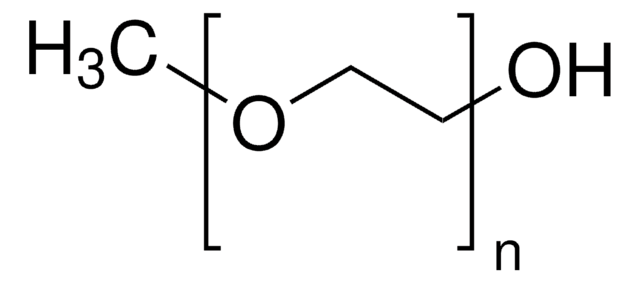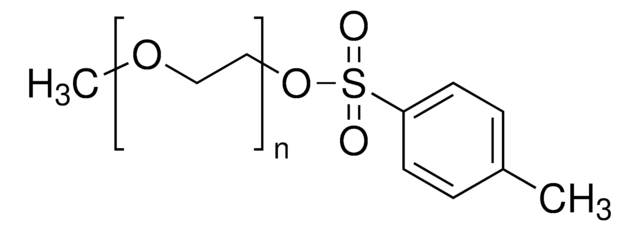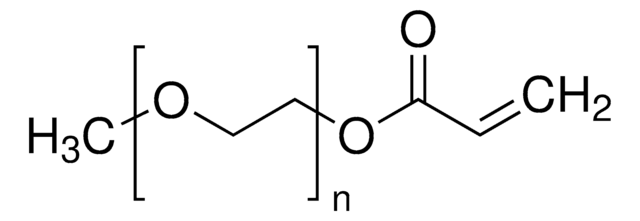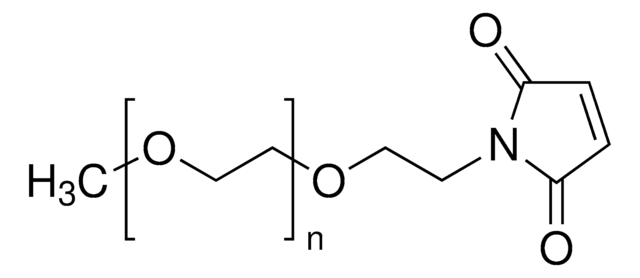202495
Poly(ethylenglycol)methylether
average MN 750, methoxy, hydroxyl
Synonym(e):
Methoxy-polyethylenglykol, Polyethylenglykol-monomethylether, mPEG
About This Item
Empfohlene Produkte
product name
Poly(ethylenglycol)methylether, average Mn 750
Dampfdichte
>1 (vs air)
Dampfdruck
0.05 mmHg ( 20 °C)
Form
paste
solid
Mol-Gew.
average Mn 750
Brechungsindex
n20/D 1.459
Viskosität
10.5 cSt(210 °F)(lit.)
Übergangstemp.
Tm 30 °C
Dichte
1.094 g/mL at 25 °C
Ω-Ende
hydroxyl
α-Ende
methoxy
InChI
1S/C3H8O2/c1-5-3-2-4/h4H,2-3H2,1H3
InChIKey
XNWFRZJHXBZDAG-UHFFFAOYSA-N
Suchen Sie nach ähnlichen Produkten? Aufrufen Leitfaden zum Produktvergleich
Anwendung
- As a chain transfer agent to synthesize amphiphilic block copolymers by metal-free ring-opening oligomerization.
- As a precursor to prepare retinoic acid-polyethylene glycol nanoassembly as an efficient drug delivery system.
- To prepare diblock copolymer with polylactic acid, which can be applied in the field of tissue engineering and drug delivery.
Lagerklassenschlüssel
10 - Combustible liquids
WGK
WGK 1
Flammpunkt (°F)
359.6 °F - closed cup
Flammpunkt (°C)
182 °C - closed cup
Persönliche Schutzausrüstung
Eyeshields, Gloves
Analysenzertifikate (COA)
Suchen Sie nach Analysenzertifikate (COA), indem Sie die Lot-/Chargennummer des Produkts eingeben. Lot- und Chargennummern sind auf dem Produktetikett hinter den Wörtern ‘Lot’ oder ‘Batch’ (Lot oder Charge) zu finden.
Besitzen Sie dieses Produkt bereits?
In der Dokumentenbibliothek finden Sie die Dokumentation zu den Produkten, die Sie kürzlich erworben haben.
Kunden haben sich ebenfalls angesehen
Artikel
Fouling Resistant Biomimetic Poly(Ethylene Glycol) Based Grafted Polymer Coatings
Progress in biotechnology fields such as tissue engineering and drug delivery is accompanied by an increasing demand for diverse functional biomaterials. One class of biomaterials that has been the subject of intense research interest is hydrogels, because they closely mimic the natural environment of cells, both chemically and physically and therefore can be used as support to grow cells. This article specifically discusses poly(ethylene glycol) (PEG) hydrogels, which are good for biological applications because they do not generally elicit an immune response. PEGs offer a readily available, easy to modify polymer for widespread use in hydrogel fabrication, including 2D and 3D scaffold for tissue culture. The degradable linkages also enable a variety of applications for release of therapeutic agents.
Devising biomaterial scaffolds that are capable of recapitulating critical aspects of the complex extracellular nature of living tissues in a threedimensional (3D) fashion is a challenging requirement in the field of tissue engineering and regenerative medicine.
Unser Team von Wissenschaftlern verfügt über Erfahrung in allen Forschungsbereichen einschließlich Life Science, Materialwissenschaften, chemischer Synthese, Chromatographie, Analytik und vielen mehr..
Setzen Sie sich mit dem technischen Dienst in Verbindung.




